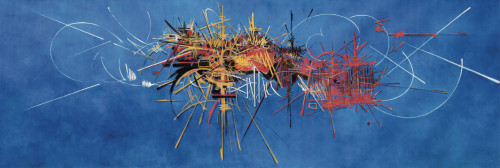
Georges Mathieu (1921–2012) took painting where it had never been before—not just in pioneering lyrical abstraction but also, remarkably, in opening it up to include performance. A prototype of the artist as global citizen, Mathieu collaborated with members of the Gutai group in Osaka, Japan; staged tour-de-force events and exhibitions throughout Europe, South America, and Israel; and was an active participant in New York’s art scene. On occasion, he’d make his cinematically scaled canvases in the street. Sometimes he wore incredible kimono-style ceremonial garb to create his pictures for museum audiences, his surfaces either tacked to the wall or laid onto the floor. He incorporated photography and film into his practice to capture his painting performances, which were characterized by a wild repertoire of spontaneous movements full of dramatic rushes and running lunges, with the artist utilizing an arsenal of long brushes and plenty of tubes of paint. His intense, meditative focus in this documentation is very compelling—it’s apparent that, while performing these spectacles, he wasn’t in the world you and I share in any ordinary sense.
Major museums collected Mathieu’s work, and he was compared to Willem de Kooning and Jackson Pollock. Eventually, however, he fell out of favor—his flamboyance and theatricality ultimately proved too much for American audiences and artists alike in the sober milieu of the New York School. His last show in the United States was in 1987. But more than thirty years later, Nahmad Contemporary and Perrotin remedied this appalling absence in a major exhibition by presenting canvases and works on paper—with an ample selection of archival materials—that spanned his lengthy career from the beginning of the 1950s to the early 1990s.
Whether Mathieu produced his work in public or in more intimate settings, his signature style is characterized by densely worked calligraphic fields that hover in empty space. Like choreographic schemes, they are rhythmic traces of an extended moment in time indexed to the movements of the body. Mathieu produced dozens of these experimental gargantuan paintings, three of which—alongside fifty more canvases that are modestly scaled, at least by comparison—were featured in this dual-venue retrospective, the artist’s first in New York. And believe me, they are stunners.
One of these, Paris, Capital of the Arts, 1965, which is nearly thirty feet wide, features a vast expanse of sky blue showcasing skeins of marks and flourishes in red, yellow, black, and white that are suspended in the painting’s radiant atmospherics. It’s as though we’re seeing a mirage of heraldic shields fluttering and unfurling on a distant horizon. The Victory of Denain, 1963, measuring more than twenty feet across, teems with kinetic energy as forms flicker and flare like fireworks against a field of modulated brown that suggests warfare under a dawning light. The title references a battle in 1712 that took place between French troops and Dutch and Austrian forces—a melee that comes across like a full-frontal assault on the canvas. Through his intuitive style and bravura, Matheiu balances unbridled aggression and heroic passion with exquisite sensitivity to nuance and detail.
Equally expansive is Matta Slums, 1978, rendered in black and white and a range of grays. The work calls to mind an animated “floating world” that effloresces vaguely architectural constellations and morphing pathways, which invite the viewer into the composition. Many other large but less monumental canvases featured abstract tableaux that felt like nocturnal illuminations or apparitions of thought. Mathieu also produced streamlined automatist gestures against monochromatic white grounds in works that relinquish grandeur for intimacy and quietude. In later paintings, such as Immensite désemparée (Dismayed Intensity), 1989–90, and L’infini funeste (Ill-Fated Infinity), 1990, the artist utilized dark tones and field effects to create dense enigmatic surfaces. There is so much to unpack and consider in Mathieu’s art. Let’s hope this wasn’t our last chance to experience this artist’s visionary oeuvre.